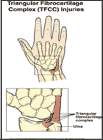
Triangular Fibrocartilage Complex (TFCC) Injuries
What is the triangular fibrocartilage complex (TFCC)?
The triangular fibrocartilage complex (TFCC) is a small piece of cartilage and ligaments on the little-finger side of the wrist, located just past the end of the forearm bone (ulna). Cartilage is a tough rubbery tissue that acts as a cushion for the joint. The ligaments are strong bands of tissue that attach the cartilage to bones in the wrist. The ligaments or cartilage can be torn during a wrist injury.
How do TFCC injuries occur?
TFCC injuries are usually caused by:
- a fall onto the outstretched hand
- a direct blow to the little finger side of the wrist or hand
- swinging a bat or a racquet
- a violent twist of the wrist at work or in sports.
What are the symptoms?
Symptoms include:
- pain on the little-finger side of the wrist
- clicking sound or feeling or a catching sensation when moving the wrist.
How is it diagnosed?
Your health care provider will ask about your symptoms and examine your wrist and hand.
Among tests your provider may order are:
- x-rays
- an arthrogram, which is an x-ray done after special dye is injected into the wrist to outline the injured structures
- an MRI (magnetic resonance image), which is a scan that uses radio waves and magnets to produce images of body structures in cross-section.
Arthroscopy may be necessary to diagnose the tear. Arthroscopy is a surgical procedure in which a small fiber-optic scope is inserted into your wrist so your doctor can look inside your wrist.
How is it treated?
The treatment of TFCC injuries include:
- using protective support such as a splint or a cast
- putting ice on your wrist for 20 to 30 minutes 3 to 4 times a day
- taking anti-inflammatory medicines such as ibuprofen
- doing wrist rehabilitation exercises
- having an injection of a cortisonelike medication.
A complete tear may require surgery. Many tears become painless with rest and time even if they don't actually heal.
When can I return to my sport or activity?
The goal of rehabilitation is to return you to your sport or activity as soon as is safely possible. If you return too soon you may worsen your injury, which could lead to permanent damage. Everyone recovers from injury at a different rate. Return to your sport or activity will be determined by how soon your wrist recovers, not by how many days or weeks it has been since your injury occurred. In general, the longer you have symptoms before you start treatment, the longer it will take to get better.
You may return to your sport or activity after your wrist injury when the injured wrist has full range of motion without pain. Your health care provider may allow you to return to competition with your wrist taped or in a brace. Your injured wrist, hand, and forearm need to have the same strength as the uninjured side. There must not be any pain when you do activities such as swinging a bat or a racquet or tumbling in gymnastics.
How can I prevent a TFCC injury?
Many injuries are caused by falls or blows that cannot be prevented. In racquet sports it is important to use good technique to prevent injury.

